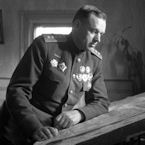BletchleyGeek
Posts: 4713
Joined: 11/26/2009
From: Living in the fair city of Melbourne, Australia
Status: offline

|
Ok, I think I'm wasting my time, if you don't have the game, with each of these general statements you make, you should acknowledge you don't have direct experience of WitE.
I will address separately these unfounded claims you make, in order.
This will be Statement #1
quote:
ORIGINAL: herwin
The OCS series seems to be able to cope, but the logistical model is more sophisticated than that in WitE. You have to get the supply to the army dumps somehow, and then throw it to the divisions/brigades/regiments that need it. If the rail network is not available, that means trucking it forward.
and this Statement #2
quote:
ORIGINAL: herwin
Care to justify your statement with evidence? The models in the two games cover the same areas, but the OCS system is much less abstract. In OCS you actually have to set up and run the supply network and it is critical to garrison your dumps and logistics infrastructure.
Let's speak WitE
quote:
ORIGINAL: WiTE manual (ammended), p. 175
"Amateurs study tactics; professionals study logistics."
All units must have access to an adequate amount of supply to function effectively. There are three types of supply in Gary Grigsby‟s War in the East; general supplies, ammunition and fuel. General supplies, to include ammo and fuel, are generated by each side‟s production system.
In order for units to receive supplies during the supply segment of the logistics phase, they must be within range of the supply grid, the main part which consists of permanent supply sources connected by a rail network of undamaged rail line hexes and including stockpiles of supply
in city and urban hexes. Ports can also be connected to the supply grid, allowing tracing of supply over water. The generic vehicles of the motor pool are used to bridge the gap between the last connected, undamaged rail line hex, called a railhead and considered a supply source,
and the unit requiring supply. Supply is most effectively delivered through the headquarters unit to which the combat units are attached, but can also be delivered directly from the railhead to the combat unit if they cannot trace to their higher headquarters unit. The amount of supply delivered is dependent on many factors, to include the distance from the railhead to the unit, whether the unit moved during the last turn, and vehicle shortages in both the motor pool and the unit. Supply can be stockpiled in supplies and fuel dumps at headquarters units and players can target specific Axis Corps or Soviet Armies for a buildup of supplies. Units can be in one of three supply states; in supply, beachhead supply, and isolated. Isolation can be either due to an inability to trace supply or the distance from the unit to a supply source being too long. Isolated units can only be supplied by air. Town, city and urban hexes that are isolated or lack a nearby supply source will suffer starvation damage to its manpower.
I don't think it's necessary to post the entire chapter here nor, this is as far as “fair use” goes. Well, maybe you will say that's the manual is fake, and WitE engine doesn't simulate what it tries to simulate. Let's see some screenshots from a live game.
First, here you can see the supply report for one of my Rifle Divisions

You can see that logistics is modeled with much more detail than in OCS, but it's run by the machine, not you. See that supply is broken down into three separate categories which influence, respectively, fatigue recovery, mobility and combat power. Below you can see a detailed report of what has been delivered (from the Army HQ) to this particular unit.
For HQ units, you can get some more info

26th Army is being supplied from the depots at the nearby city of Novy Oskol. See that since the range is really short, 20 miles (or two hexes), supply delivery is working at full efficiency.
Let's take a look at 28th Army, which is “trapped” in Leningrad between 18. Armee and the Finnish Army

Here the logistical situation isn't nearly as good. Depots in Leningrad and nearby towns are all depleted by now, and supply only is traced over the Ladoga lake. Note how the supply relay efficiency has been severely degraded.
OCS is a great, if not the greatest, operational hex-and-counter wargame ever. But WitE can model what OCS needs to abstract greatly and simulate stuff that's just beyond the reach of OCS, because, it's a computer program. You seem to have a really weird notion of “abstraction”.
If you have WitE then you have barely played it or read the manual or whatever. If not, well, you could have just said something like, "hey, could anyone explain to me how are logistics modeled in WitE?", rather than making bland generic statements from I don't know precisely what lofty mountain.
_____________________________
|
 Printable Version
Printable Version

 I've got OCS Burma and read a lot about it, and it isn't precisely what I would call a "lightning campaign". I think I missed the part on the British laying highways and gas stations along the Irawaddy.
I've got OCS Burma and read a lot about it, and it isn't precisely what I would call a "lightning campaign". I think I missed the part on the British laying highways and gas stations along the Irawaddy. 












 Indeed. I was thinking more of spending MP's until getting adjacent. Forcing a hasty attack by the intercepting unit would even spice things more. Plenty of possibilities open up while in the offensive or the defensive for both sides.
Indeed. I was thinking more of spending MP's until getting adjacent. Forcing a hasty attack by the intercepting unit would even spice things more. Plenty of possibilities open up while in the offensive or the defensive for both sides. 





 New Messages
New Messages No New Messages
No New Messages Hot Topic w/ New Messages
Hot Topic w/ New Messages Hot Topic w/o New Messages
Hot Topic w/o New Messages Locked w/ New Messages
Locked w/ New Messages Locked w/o New Messages
Locked w/o New Messages Post New Thread
Post New Thread